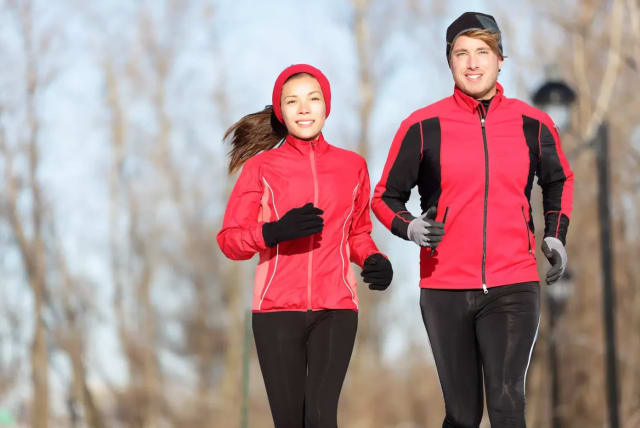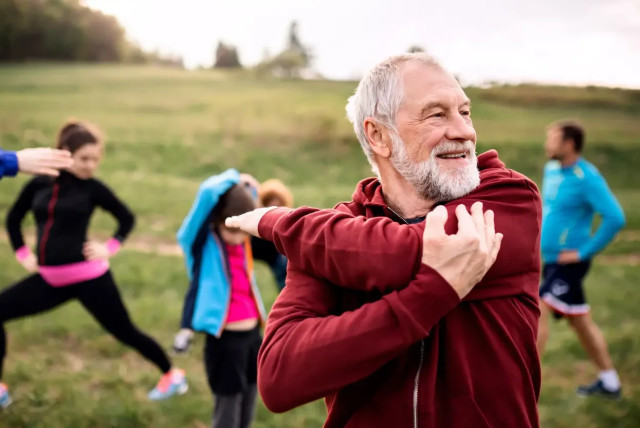The advantage of running in winter: Burning more calories

It takes determination to go training outdoors in the freezing cold, but what if we told you that, specifically in winter, any aerobic activity you do will burn more calories? Experts explain.
During the winter season, the temptation to spend more hours indoors than outdoors is common for many people. However, maintaining an active lifestyle during the cold months is crucial for overall health and well-being.
Physical activity during the winter has many positive effects on the body's health, disease prevention, and weight management.
Research in the field shows that people who continue to engage in moderate physical activity during the winter are 20% less likely to suffer from upper respiratory infections.
Therefore, it is recommended to train throughout the year, especially during the winter, when it comes to holistic training that includes aerobic endurance, strength, coordination, and flexibility.
Here are some tips for physical activity in winter and general safety precautions to be mindful of:
- Dress in layers suitable for winter: Appropriate clothing is vital for winter workouts. Layering helps regulate body temperature and ensures that the body stays warm without overheating. It is recommended to wear moisture-wicking clothing to keep sweat away from the skin and to add an insulation layer. Additionally, in the case of cold and rainy weather, a water and wind-resistant outer layer is advised.
- Caloric expenditure during outdoor aerobic activity: Running against the wind or in the rain requires much higher caloric expenditure than in mild weather conditions, due to the difficulty of performing the activity in challenging conditions that raise heart rate and more. This is especially significant in activities that involve impact (foot detachment from the ground).
- Winter training outdoors and increased RMR (Resting Metabolic Rate): The characteristic of physical activity in the cold is the increased breakdown of glycogen stores (carbohydrate stores in the liver and muscles) and, consequently, an elevation in fat metabolism. Thus, increased glycogen utilization leads to a decrease in its quantity in the body, causing muscles to use fat as a preferred energy source. The hormone adrenaline, released during physical activity, also contributes to the utilization of these fats as an energy source (contributing to increased fat burning). Cold conditions increase RMR in order to maintain a proper body temperature. The advantage of physical activity in winter is its contribution to increased caloric expenditure.
- Importance of drinking water during winter and especially during physical activity: Although it is not as prominent as in hot weather, maintaining hydration is essential even in winter. Cold air tends to be dry, and inhaling dry air can lead to increased fluid loss. Therefore, it is important to drink water before, during, and after exercise to maintain optimal hydration levels. Harsh weather conditions, which are also characterized by variable surface conditions, require special effort. Therefore, even in winter, it is recommended to drink 10 cups of fluids or more, especially for prolonged aerobic exercises.
- Pre-activity warm-up: Cold muscles are more prone to injury, so it is crucial to dedicate extra time to warm-up in the winter. For example, dynamic stretches (in motion), light aerobic exercises, and exercises that involve joint movements. Intense short efforts usually require significantly more preparation than long-duration efforts. For example, a 5 km. race requires relatively more preparation (warm-up) than a marathon (42.195 km.) due to the intensity of the effort.
- Indoor training: On days when the weather is particularly harsh, it is especially important to have a backup plan for indoor training, such as stationary biking, swimming, yoga, or strength training at home or in a local gym, to stay active regardless of the weather.
- Choosing an outdoor route for aerobic activities (such as walking, running, cycling, etc.) where you can enjoy the winter scenery: The location of the training generally also influences the motivation of the trainee. For example, running on the beach, in the forest, in a park, by a lake, and similar locations are especially enjoyable and contribute to motivation and perseverance in the activity.
- Training with a friend or in a group: Especially in cold or uncomfortable and challenging weather conditions, training with someone else or in a group can greatly contribute to motivation and perseverance in workouts.
- Applying sunscreen to exposed areas of the body, including the face: It is highly recommended not to skip applying sunscreen. Exposure to winter sun, combined with reflective surfaces like snow, can cause skin burns.
- Pay attention to temperature: Human body systems function less efficiently in hot or cold conditions because it disrupts homeostasis (the body's self-regulation processes). Therefore, the body needs to regulate itself through increased sweating. For example, when it's hot, the body cools itself down through sweating, and when it's cold, it copes by shivering or goosebumps, which help the body warm up.
- Recovery after exercise: After exercising in cold weather, it is recommended to perform a little relaxation: stretching and rest for a few minutes. Additionally, a warm drink, such as herbal tea or hot chocolate, can be very soothing and calming after dealing with the cold, especially in low temperatures.
- Exposure to illnesses during the winter: It is known that there is an increase in the prevalence of illnesses in the winter, so it is not recommended to train while sick. Moreover, doing so may worsen the trainee's health condition. Also, training in enclosed places such as gyms, studios, and the like, can also lead to the infection of other trainees.
- Safety when performing outdoor activities in winter: Aerobic activity, in particular, increases the risk of falls due to slippery surfaces, possible changes in terrain such as rocks that may be on the running/walking/cycling path due to the wind. Braking should be done more slowly, especially when the activity is done on a road with cars and pedestrians. It is important to have better visibility in the evening or during rain. Therefore, it is important to engage in activities with reflective clothing and a flashlight.
- Eating during outdoor activities in winter: When it comes to prolonged training in cold weather conditions, it is important to prepare nutritionally and even consult with a clinical dietitian regarding the recommended types of food and the timing of consumption. In some aerobic activities, it is possible, of course, to eat and even drink during activity (this is more problematic in activities involving detachment of the foot from the ground).
- Caution, hunger increases in winter. The feeling of hunger is sometimes common after outdoor activities during the winter period, especially after high-intensity workouts in the rain, swimming, and more. It is important to pay attention that athletes do not consume an increased amount of calories that is not reasonable after outdoor activities – which can, of course, lead to weight gain, as the total calories consumed will be higher in this case than the calories they use.
Jerusalem Post Store
`; document.getElementById("linkPremium").innerHTML = cont; var divWithLink = document.getElementById("premium-link"); if (divWithLink !== null && divWithLink !== 'undefined') { divWithLink.style.border = "solid 1px #cb0f3e"; divWithLink.style.textAlign = "center"; divWithLink.style.marginBottom = "15px"; divWithLink.style.marginTop = "15px"; divWithLink.style.width = "100%"; divWithLink.style.backgroundColor = "#122952"; divWithLink.style.color = "#ffffff"; divWithLink.style.lineHeight = "1.5"; } } (function (v, i) { });

